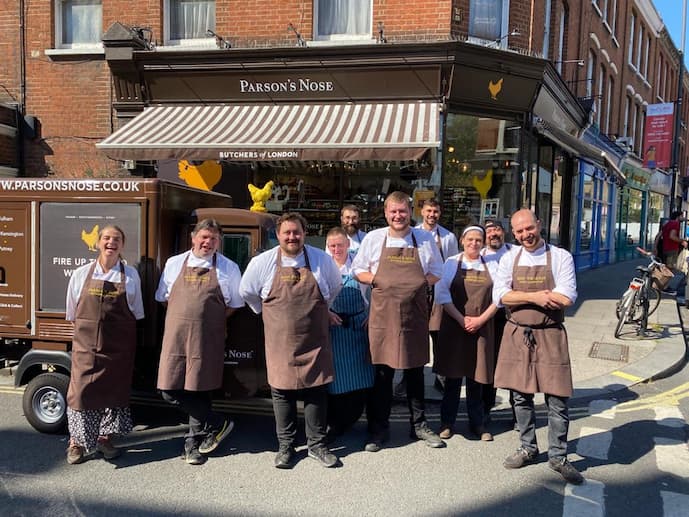Here at Parson’s Nose, we started our mission with the ambition to bring back the traditional butcher’s shop, bringing back the values and techniques that has, over time become a dying art.
In aid of National Butcher’s Week, we look back at the history of butcher’s shops and how they’ve changed to fit the shopping demands of the 21st century.
The Traditional Butchers Shop: A Brief History
Butchers can be traced back centuries, having been evidenced in Roman or even Prehistoric times, where the love of meat began and steps towards an impactful and game-changing industry took shape.
The Roman Era: The Introduction to the Butchers Shop
Romans brought with them different skills and approaches to meat, introducing the chopping block and cleaver. This caused game-changing adaptations to the world of butchery.
During the early stage of butcher shop development, it was common belief that nothing was to be wasted. With many meat merchants heading to market to sell their stock, butchers began standing out as they specialised in the more complex cuts of meat such as heads and feet and how to make use of these in cooking.
This new take on ‘the meat market’ helped to increase the popularity of meat across the community, helping to secure the Butcher’s Shop as a reliable and essential food source, which helped to introduce the concept of trade and barter for necessary produce.
The Medieval Relationship with The Butcher
Moving towards the Middle-Ages, butchery had secured itself as a fully-fledged, money-making institution. The introduction of ‘The Butcher’s Guild’, a moral code within a trade, ensured that some health and safety regulations were introduced to ensure safe consumption, alongside the thriving environment of the livestock market.
However, with distinct hierarchy within society, otherwise known as the feudal system, meant that there was a clear class divide when it came the luxuries the general public could afford and enjoy, with the majority of meat being set aside for those of higher class or nobility.
In fact, during this time butchers were highly respected during these times due to their superior knowledge of anatomy, much like doctors or dentists.
The Victorian Era: The Popularity of The Butchers Shop
The 19th century saw a big shift for the local butcher, with the population growing and many of those quickly populating the towns and cities, urban butcher shops were busier than ever.
A trip to the butcher was a daily occurrence for many in a Victorian households to ensure a fresh and nutritious meal.
Meat became a hugely popular source of food, and Victorians stuck with the ‘waste not want not’ attitude seen in Roman times, using as much of the animal as possible. The wealthy would enjoy large roasting joints, using the bones and excess cuts to create soups and more. The lower classes used cheaper cuts, and scraps of meat to make hearty dinners such as sausages and stews.
The 20th Century: The Beginning of a Decline
The beginning of the 20th century saw huge improvements for the local butcher, with the industrial use of refrigeration and health a safety acts being implemented, the butcher continued to thrive, even during the war when meat was rationed. However, this all began to change with the introduction of the supermarket in the late 1940s. By the time the 60s arrived, several supermarkets had opened across the UK, and we began to see a decline in local butcher services, with some being forced to close.
Supermarkets removed the need for interaction, you could buy all you required in one place, removing the need for the baker, greengrocer, and butcher as separate entities.
Modern Times: How the Butcher’s Shop Has Changed for the 21st Century
At the beginning of the 21st century, there was a huge concern whether butchers would continue to survive the market.
According to a study conducted by AHDB, “over the last 25 years, the number of independent butchers in the UK has reduced by 60%”, thanks to the influx of supermarkets as grocery providers, meaning many butchers and other food markets were being forced to close due to minimal sales.
However, there has been a steady return to the traditional butchers shop, with more people looking to shop local and support more independent traders.
What 2020 Meant for Butchery
It is thought that independent butchers saw a spike in sales during the pandemic, with many looking towards, and becoming loyal, to these local providers after the struggles of panic buying left shelves bare, as well as the desire to avoid supermarkets with a larger capacity.
The spike of interest in local butcher shops have continued. Many have been returning to the traditional butchers shops that people remember fondly, enjoying a more personal customer service and improved meat quality, well as being able to ask questions, tips and suggestions for their meals.
With a modern market forcing change, we have seen the industry adapt, beginning to cater towards a new era of shopping habits.
Butchers shops like ours have introduced online butchers, and masterclasses, click and collect options and deliveries, it has been vital to adapt towards customer behaviours of increased online shopping, whilst still creating a personal, worth-while service that customers won’t get anywhere else.
We have no idea what the future of independent butchers will look like, but we’re looking forward to finding out!
Here at Parson’s Nose, we take pride in our customer service, our expert butchers are always on hand to offer advice on the best meat to suit your needs. Whether you’re looking for restaurant grade ready meals or an ultimate burger kit, through our quality meat we’re striving to keep the high street butcher alive.
Buy online or pop in-store to speak with our expert team today.




-66e018ff8a7de.png)